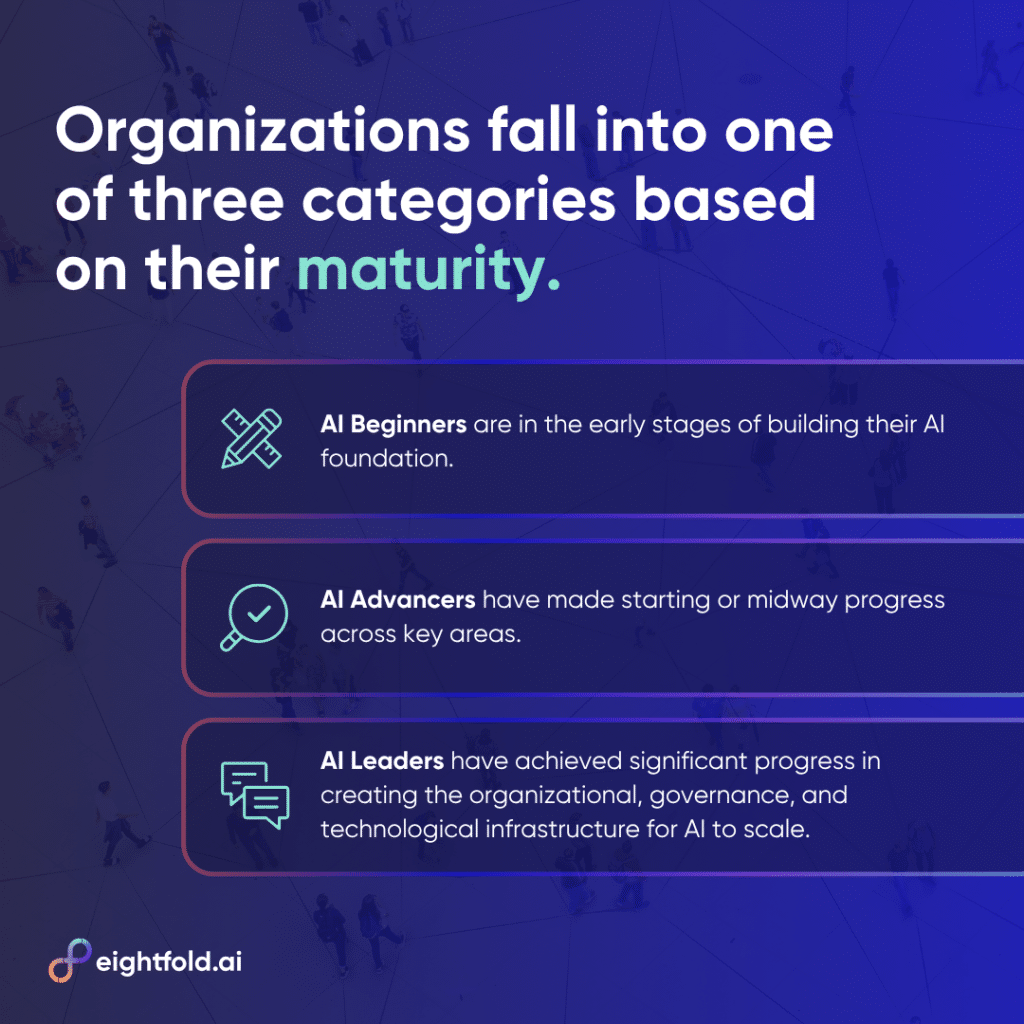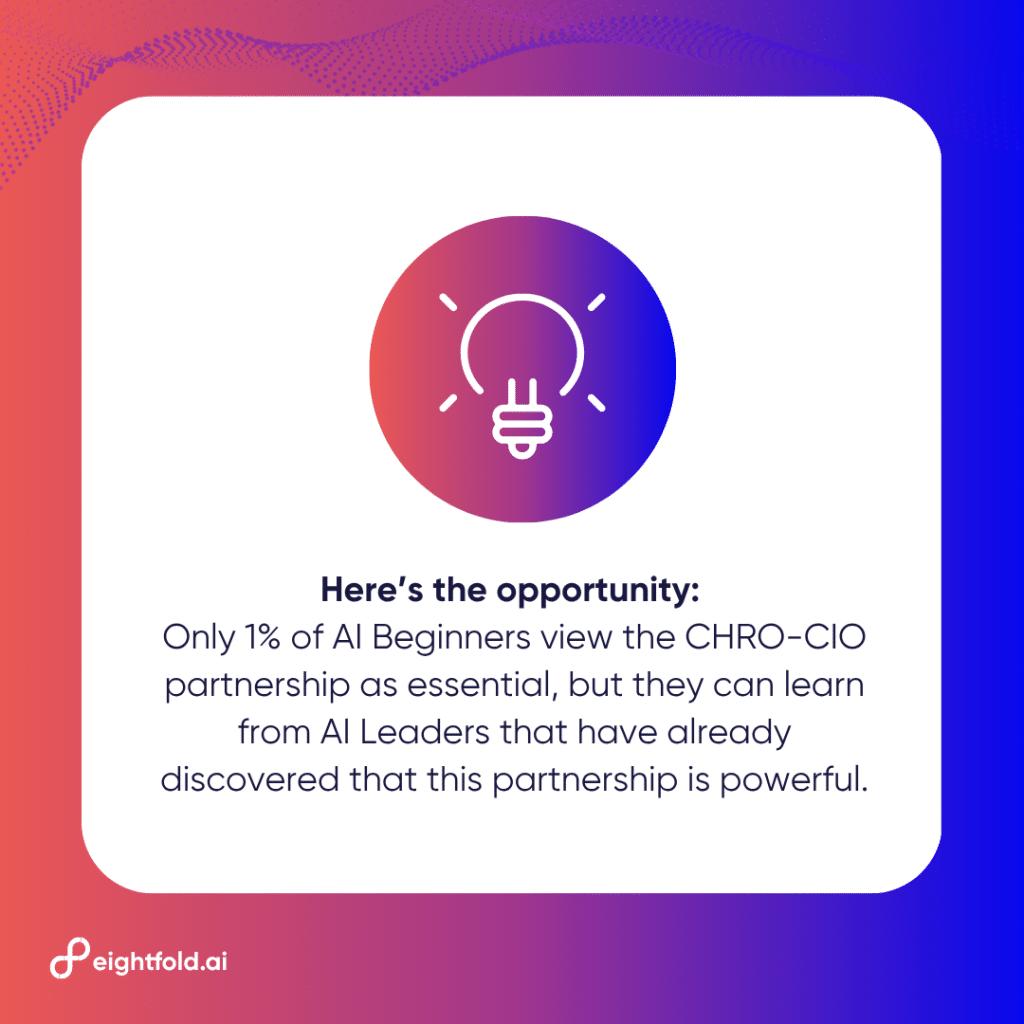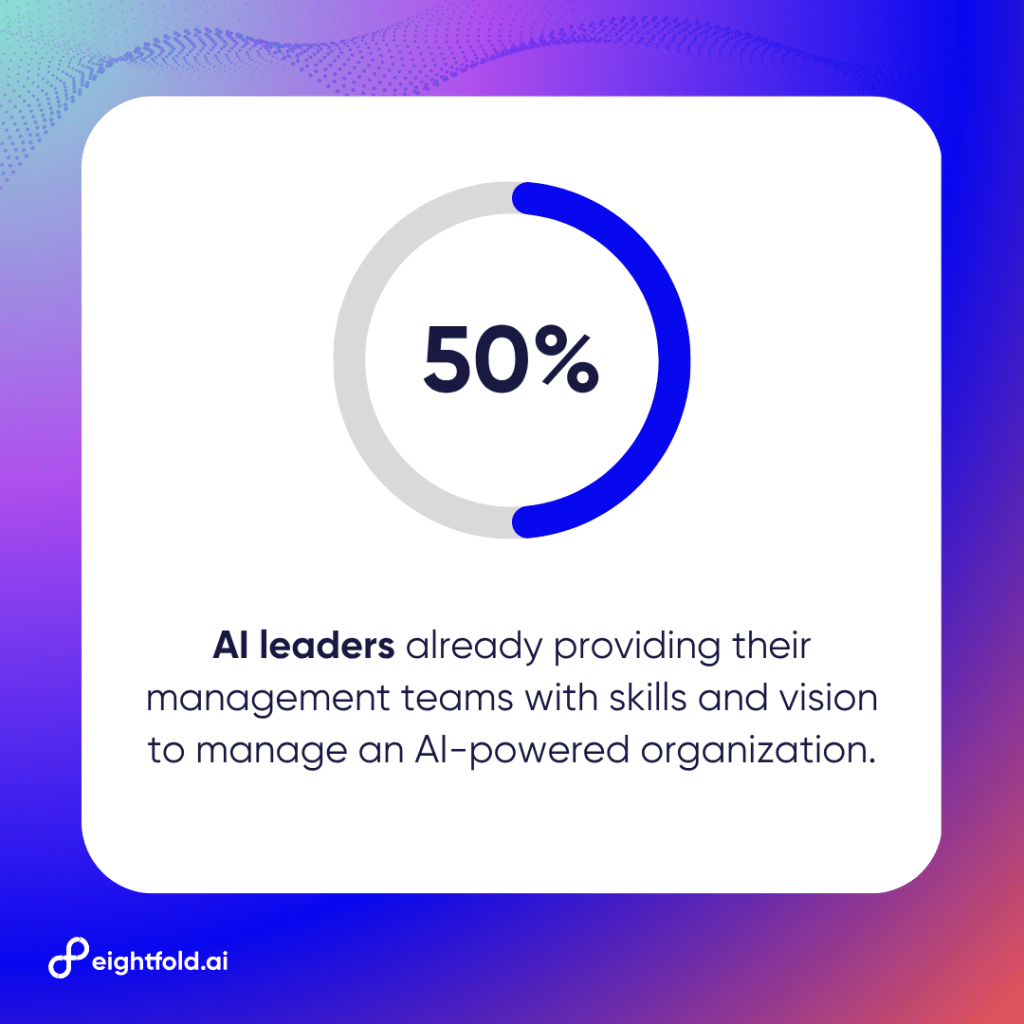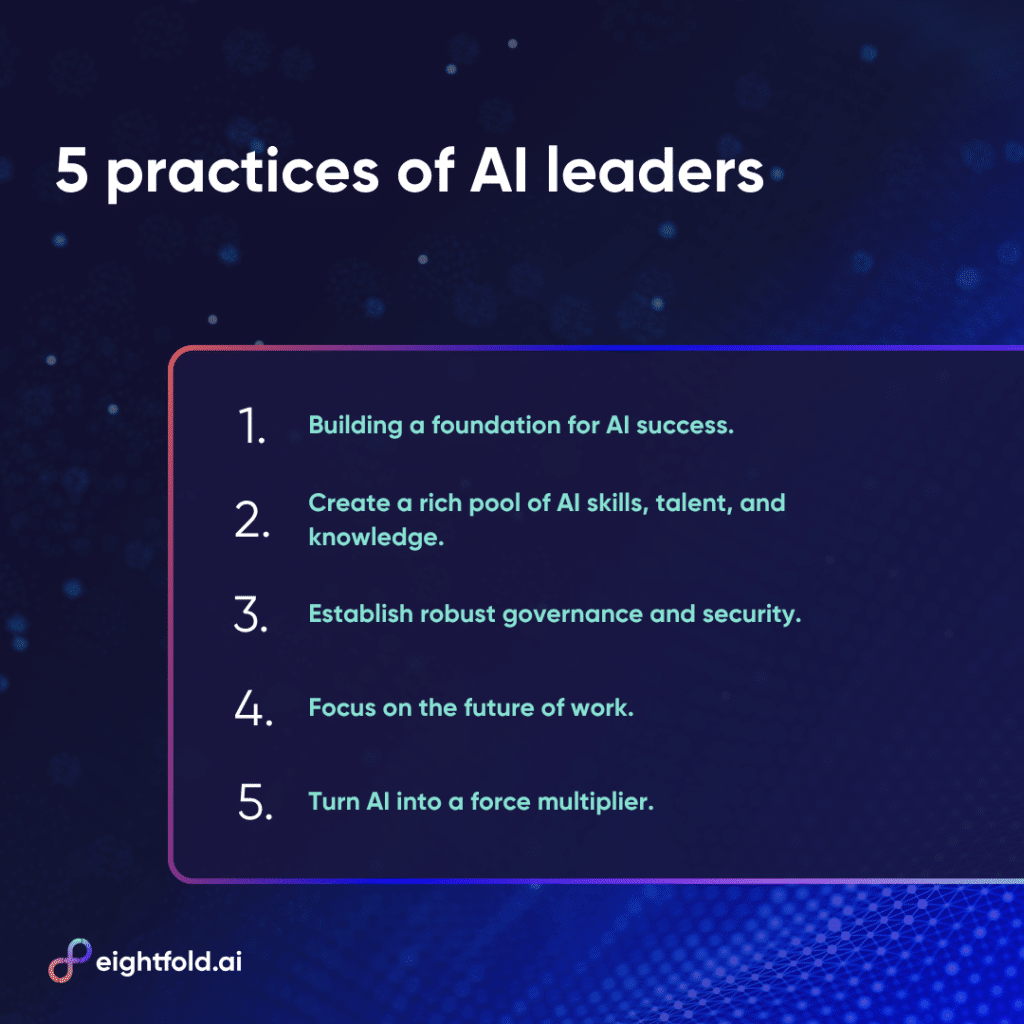- The CHRO-CIO partnership is the key differentiator for AI success. According to our latest survey, the organizations with the most mature AI implementations — and a clear partnership between people and technology functions — have a clear head start over those just starting.
- The talent-tech connection is essential for success. AI transformation is fundamentally about people, not just technology. Skills development, change management, and cultural adaptation require CHRO expertise, with 64% of organizations citing AI skills gaps as the biggest challenge to transformation.
- Leading organizations follow five clear practices that build alignment, develop AI talent, establish governance, and prepare for AI-human collaboration, resulting in 3x more benefits than beginning organizations.
Here’s a fascinating insight from our latest research: while eight out of 10 organizations beginning AI journeys view CHROs as playing a small role in transformation, 90% of organizations leading in AI adoption and integration have discovered something different — a strong CHRO-CIO partnership is absolutely essential to success.
That difference in perspective isn’t only interesting. This collaboration between the top offices for people and tech transformation is the key to unlocking the full potential of AI in your organization.
If your organization is like most, you’re navigating the complex journey of AI transformation — moving beyond initial pilots and working toward enterprise-wide impact.
Our latest survey, “AI transformation: The new role of the CHRO,” reveals what’s working for organizations succeeding with AI initiatives, and how involving your CHRO can accelerate progress. Here are the major takeaways.

Understanding where most organizations are today
Our research of 700 organizations across North America, Europe, and Asia Pacific shows that AI transformation is well underway across industries. We assessed organizations across seven foundational pillars — from leadership alignment and governance to talent development and future-of-work planning — and grouped them into three categories based on their maturity:
- AI beginners (21%) are in the early stages of building their AI foundation.
- AI advancers (56%) have made starting or midway progress across key areas.
- AI leaders (24%) have achieved significant progress in creating the organizational, governance, and technological infrastructure for AI to scale.
The journey varies by where your organization is in the process. Many of you are working through leadership alignment — about two-thirds are starting or midway through this critical step. This makes sense, since alignment across diverse stakeholders takes time and intentional effort.
The opportunity to address human dynamics
What’s becoming clear is that AI transformation extends far beyond technology implementation. The most impactful challenges involve people and organizational culture. Among organizations in the middle of their AI journeys, 64% cite lack of AI skills and knowledge as their biggest barrier to AI innovation, while 55% face staff resistance to change.
This presents an exciting opportunity. These fundamentally human challenges are exactly where your CHRO can make the biggest difference — yet many organizations haven’t fully tapped into this potential.

An untapped resource: The CHRO’s strategic potential
If you’re in the earlier stages of the AI journey, you have a valuable opportunity to increase your project’s success by involving your CHRO more strategically. Currently, about eight out of 10 AI beginners see CHROs playing a limited role, and 57% report that initiatives are primarily driven by technology or business units.
Of those same organizations, only 7% report strong CHRO-C-suite collaboration, and just 1% currently view the CHRO-CIO partnership as essential.
Here’s the opportunity: AI beginners can learn from AI leaders that have already discovered how powerful this partnership is.
Among organizations at early or intermediate maturity levels, only 10% have made significant progress in defining how the CHRO and CIO will work together, and just 5% have made significant progress in exploring collaborative working methods between these roles. There’s significant room to grow here — and clear models to follow.
What AI leaders have discovered: The power of partnership
Our research identified an impressive 24% of organizations as AI leaders, those that have made significant progress in creating the organizational foundation for AI innovation.
The secret? These organizations have unlocked the potential of a strong CHRO-CIO partnership.
The results speak volumes:
- 90% of leaders have found that AI transformation thrives with a strong CHRO-CIO partnership.
- 87% of leaders report the CHRO plays a vital role in building a culture of trust and transparency.
- 89% of leaders see the CHRO leading reskilling and upskilling efforts in response to AI-driven changes in roles and work processes.
This partnership is transforming how work gets done. AI leaders report that CHROs and CIOs are collaborating to empower people with AI, build AI-enabled workflows, provide enhanced experiences, drive responsible AI implementation, and co-create business strategies together.
“AI is transforming how we discover and develop strategies,” said a CIO from a UK-based health care and life sciences company in our survey. “I view the CHRO as an important partner in this — ensuring our people are well-equipped, deeply engaged, and empowered to survive in an AI-first environment.”

The AI Leader advantage: Unlocking organizational potential
Because AI leaders have strategically engaged CHROs in AI adoption and scaling, these organizations are excelling at navigating the human and logistical aspects of transformation.
These organizations are seeing:
- 81 percentage points less concern about AI skills gaps.
- 41 percentage points less staff resistance to AI.
- 36 percentage points fewer challenges with organizational silos.
- 23 percentage points fewer issues with lack of executive buy-in.
Your CHRO brings essential capabilities that complement technology leadership perfectly.
As one CTO from a U.S.-based public sector organization said in an interview for our research report: “The HR function has become more central to enterprise strategy and overall decision making.”
Different types of organizations are finding success in several ways
The path to AI leadership varies across organization size, region, and industry.
- By size: Larger organizations are moving faster: 40% of companies with 10,000+ employees have reached leadership status. Organizations with over $10 billion in revenue also show the highest AI maturity scores. This makes sense given access to resources, but it also means middle market firms have clear role models to follow — and ground to catch up.
- By region: North American organizations are slightly ahead at 30% AI leaders, compared to 18% in Europe and 24% in APAC — showing there’s opportunity for growth across all regions.
- By industry: Telecommunications (50% AI leaders) and technology (49%) are pioneering the way, followed by banking and professional services.
Large enterprises implementing AI are achieving impressive results: 40% report greater market share and competitiveness; 62% cite improved customer satisfaction; and 66% experience higher staff loyalty.

5 practices of pioneering leaders
AI leaders are following a clear playbook that anyone can adopt. Here’s what these organizations are doing:
1. Building a foundation for AI success
AI leaders start transformation from the top. Executives are deeply involved in AI pilots, and training is provided to build foundational AI knowledge and ethical awareness across the entire C-suite. These organizations also establish cross-functional teams to collaboratively own AI initiatives and clearly define how CHROs and CIOs will work together.
These organizations also carefully track progress. AI leaders keep management informed through updates, dashboards, and performance reports — and these organizations measure executive teams based on AI-specific metrics tied to innovation, adoption, and impact.
Currently, 50% of AI leaders are equipping management teams with the skills and vision to guide AI-powered organizations, and the expectation that this will reach 66% in the next two years.
2. Create a rich pool of AI skills, talent, and knowledge
AI leaders are comprehensively investing in developing AI talent and skills. These organizations establish centers of excellence, often collaborating with academic institutions and ecosystem partners.
Additionally, an impressive 97% of AI leaders offer hands-on workshops and AI literacy training for non-technical staff, and 98% provide specialized AI training tailored to different organizational roles.
These organizations also foster continuous learning by sharing AI use cases, helping everyone understand practical applications and possibilities.
3. Establish robust governance and security
AI leaders build trust through comprehensive governance. These organizations conduct layered reviews — technical, legal, and societal — of AI initiatives, especially high-risk ones. Compliance is ensured with emerging regulations like the EU AI Act and GDPR, and these organizations embed ethical principles into design workflows from the start.
This thoughtful approach pays dividends. Only 2% of AI leaders report that regulations are creating conflicting views among leadership, and just 16% feel that compliance requirements are limiting innovation — showing that strong governance actually enables faster progress.
4. Focus on the future of work
AI leaders are actively preparing for an evolved workplace. An impressive 81% of leaders recognize that as AI agents take on more tasks, the boundary between digital and human workers is evolving. Similarly, 86% see the CHRO taking on expanded responsibility to orchestrate both human and digital workers.
More than half of AI leaders have already made significant progress in developing plans to manage AI agents and creating digital workspaces where AI and humans seamlessly collaborate. The organizations are creating long-term HR plans aligned with AI transformation, shifting talent teams to anticipate future needs, and thoughtfully assessing how AI advances will shape work.
5. Turn AI into a force multiplier
The payoff for getting AI transformation right is substantial. As organizations progress from early stages to leadership, the benefits from AI innovation increase threefold. AI beginners see an average of 3.42 benefits, while AI leaders experience more than 11 distinct benefits.
The performance improvements are remarkable:
- AI leaders are 14.7 times more likely to see higher staff productivity.
- AI leaders are 13 times more likely to see higher shareholder value.
- AI leaders are 5.6 times more likely to see higher profitability.
- AI leaders are 4.4 times more likely to experience greater revenue growth.
Your AI investments can drive innovation, boost customer satisfaction, increase scalability and agility, accelerate time to market, and create entirely new business models — and the evidence shows what’s possible when you build the right foundation.
Your opportunity: Elevating the CHRO’s role
The evidence is clear: Technology transformation and people transformation work best when orchestrated together. AI transformation is about skills, change management, and breaking down silos. These are all areas where CHROs excel.
Here’s how to accelerate your progress:
- Elevate the CHRO as a strategic partner in AI transformation. Give your CHRO a seat at the strategy table with meaningful budget authority. Recognize that people transformation and technology transformation are two sides of the same coin.
- Strengthen the CHRO-CIO partnership. Make this collaboration a strategic priority with joint OKRs and regular alignment. Only 10% of organizations at early stages have made significant progress here, while 65% of AI leaders have achieved this critical foundation.
- Build the organizational foundation for sustained AI success. Many organizations are working through implementation across key initiatives — this is the perfect time to shift from pilots to enterprise-wide deployment. Build specialized AI capabilities, forge external partnerships, and create accountability with AI-specific executive metrics.
The path forward is clear
Organizations across every industry and region are discovering how to make AI transformation work. AI leaders aren’t just investing in technology — these organizations are investing in building the partnership between technology and people leadership.
What’s exciting is that the playbook is becoming clear. AI leaders have found that CHRO-CIO partnership, comprehensive skills development, robust governance, future-of-work planning, and strategic execution create remarkable results: higher productivity, greater innovation, improved customer satisfaction, and significant competitive advantages.
You have an incredible opportunity ahead. By recognizing the CHRO as a strategic partner in AI transformation — not just a supporting function — you can accelerate your progress and unlock the full potential of AI for your organization.
For more findings, download the full survey, “AI transformation: The new role of the CHRO.”
